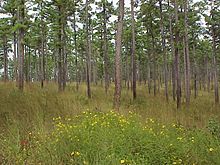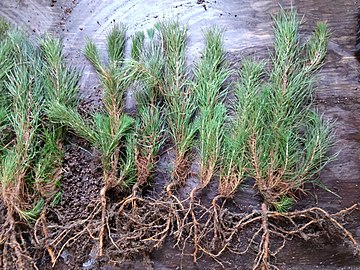bio.wikisort.org - Plant
Pinus echinata, the shortleaf pine,[2] is a species of pine native to the southeastern United States.
Description
The tree is variable in form, sometimes straight, sometimes crooked, with an irregular crown. The tree reaches heights of 20–30 metres (65–100 feet) with a trunk diameter of 0.5–0.9 m (1+1⁄2–3 ft).
The leaves are needle-like, in fascicles (bundles) of two and three mixed together, and from 7–11 centimetres (2+3⁄4–4+1⁄4 inches) long. The cones are 4–7 cm (1+1⁄2–2+3⁄4 in) long, with thin scales with a transverse keel and a short prickle. They open at maturity but are persistent.[3] Shortleaf pine seedlings develop a persistent J-shaped crook near the ground surface.[4] Axillary and other buds form near the crook and initiate growth if the upper stem is killed by fire or is severed.[5]
The bark has resin pockets, which form small depressions, less than 1 millimetre (1⁄32 in) in diameter. This feature can be used to distinguish P. echinata from all other Pinus species within its native range.[6]
Taxonomy
The Latin specific epithet of echinata refers to hedgehog, from echinus.[7]
Distribution and habitat
Shortleaf pine has the largest range of the southern US yellow pines. It is found from southernmost New York, south to northern Florida, west to eastern Texas and Oklahoma.[8]
This pine occupies a variety of habitats from rocky uplands to wet flood plains.
Ecology
With frequent fire, the species creates a savanna, with a very diverse understory and prime habitat for the red-cockaded woodpecker.[9]
The tree frequently hybridizes naturally with loblolly pine and pitch pine where their ranges intersect. Hybridization with loblolly pine has become increasingly frequent in recent decades and results in a loss of fire tolerance.[5]
Uses
This pine is a source of wood pulp, plywood veneer, and lumber for a variety of uses. The shortleaf pine is one of the southern US "southern yellow pines"; it is also occasionally called southern yellow pine or the shortstraw pine.
References
- Farjon, A. (2013). "Pinus echinata". IUCN Red List of Threatened Species. 2013: e.T42359A2974993. doi:10.2305/IUCN.UK.2013-1.RLTS.T42359A2974993.en. Retrieved 19 November 2021.
- USDA, NRCS (n.d.). "Pinus echinata". The PLANTS Database (plants.usda.gov). Greensboro, North Carolina: National Plant Data Team. Retrieved 4 October 2015.
- Kral, Robert (1993). "Pinus echinata". In Flora of North America Editorial Committee (ed.). Flora of North America North of Mexico (FNA). Vol. 2. New York and Oxford – via eFloras.org, Missouri Botanical Garden, St. Louis, MO & Harvard University Herbaria, Cambridge, MA.
- Lawson, Edwin R. (1990). "Pinus echinata". In Burns, Russell M.; Honkala, Barbara H. (eds.). Conifers. Silvics of North America. Washington, D.C.: United States Forest Service (USFS), United States Department of Agriculture (USDA). Vol. 1 – via Southern Research Station.
- Tauer, Charles G.; Stewart, John F.; Will, Rodney E.; Lilly, Curtis J.; Guldin, James M.; Nelson, C. Dana (2012-06-01). "Hybridization Leads to Loss of Genetic Integrity in Shortleaf Pine: Unexpected Consequences of Pine Management and Fire Suppression". Journal of Forestry. 110 (4): 216–224. doi:10.5849/jof.11-044. ISSN 0022-1201.
- "Silvics of Shortleaf Pine" (PDF). North Carolina Forest Service. January 2016. Archived (PDF) from the original on 2016-12-24. Retrieved 11 November 2018.
- Stearn, William (2004). Botanical Latin. Portland, Oregon: Timber Press. ISBN 9780881926279.
- "Plants Profile for Pinus echinata (shortleaf pine)". plants.sc.egov.usda.gov. Retrieved 2020-09-30.
- Hedrick, Larry D.; Bukenhofer, George A.; Montague, Warren G.; Pell, William F.; Guldin, James M. (2007). "Shortleaf pine-bluestem restoration in the Ouachita National Forest". In: Shortleaf Pine Restoration and Ecology in the Ozarks: Proceedings of a Symposium: 206-213.
External links
 Media related to Pinus echinata at Wikimedia Commons
Media related to Pinus echinata at Wikimedia Commons- Gymnosperm Database: Pinus echinata
- NCRS: USDA Plants Profile: Pinus echinata
На других языках
- [en] Pinus echinata
[es] Pinus echinata
Pinus echinata, el pino amarillo o pino de hoja corta, es una especie de pino nativa del este y sur de los Estados Unidos, de la mayor parte del estado de Nueva York, del sur hasta el norte de Florida, del oeste al este Oklahoma, y el suroeste hasta el este de Texas. El árbol es variable en forma, a veces recto, a veces torcido, con una copa irregular. Este árbol logra estaturas de 20–30 metros (65–100 ft) con un diámetro de tronco de 0.5–0.9 metros (1 ft 8 in–2 ft 11 in).[ru] Сосна короткохвойная
Сосна короткохвойная (лат. Pinus echinata) — североамериканский вид растений рода Сосна (Pinus) семейства Сосновые (Pinaceae).Другой контент может иметь иную лицензию. Перед использованием материалов сайта WikiSort.org внимательно изучите правила лицензирования конкретных элементов наполнения сайта.
WikiSort.org - проект по пересортировке и дополнению контента Википедии






